Sketchnote like a Whiz and effective strategies for learning
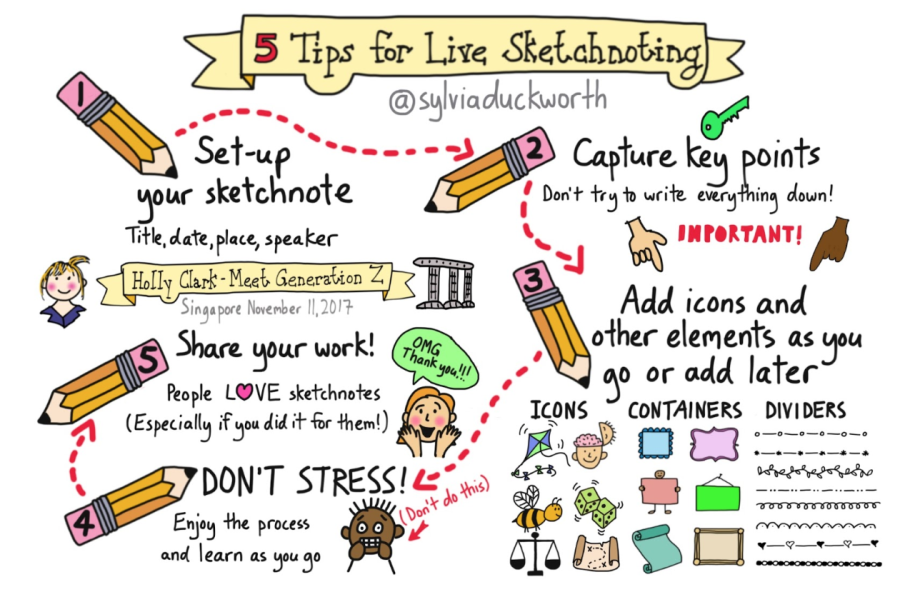
Sylivia Duckworth 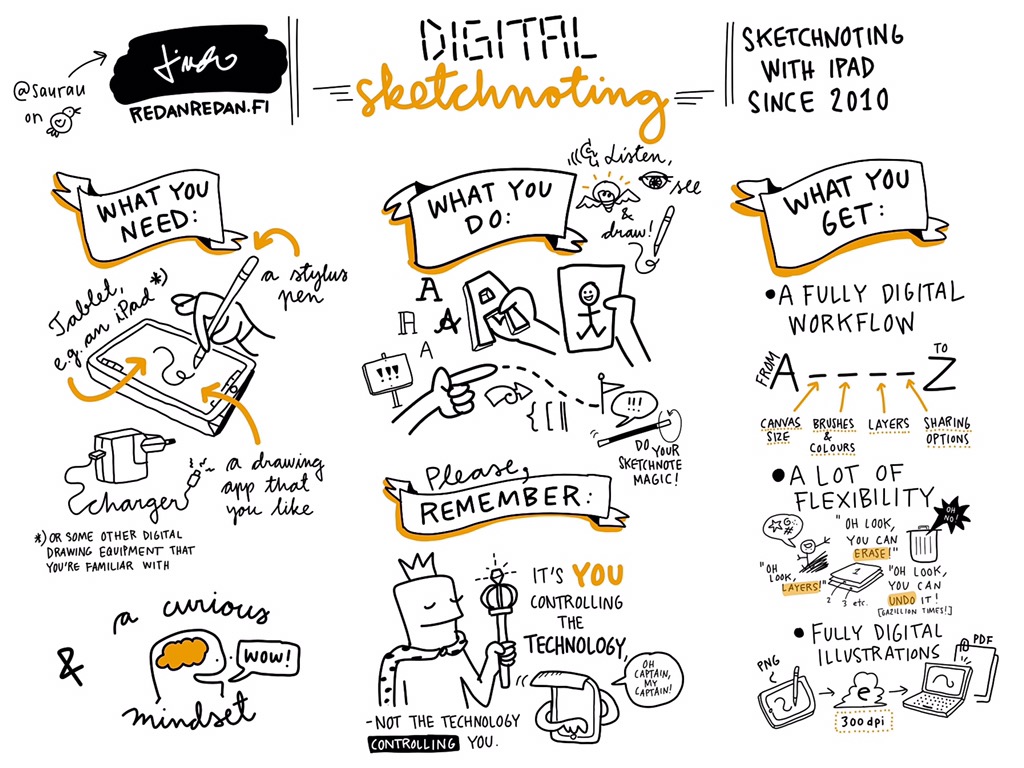

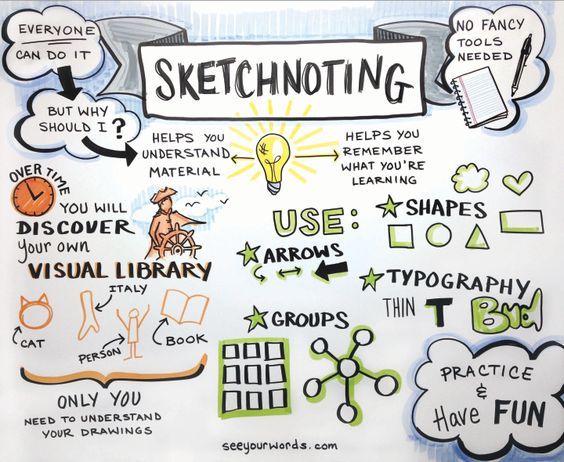
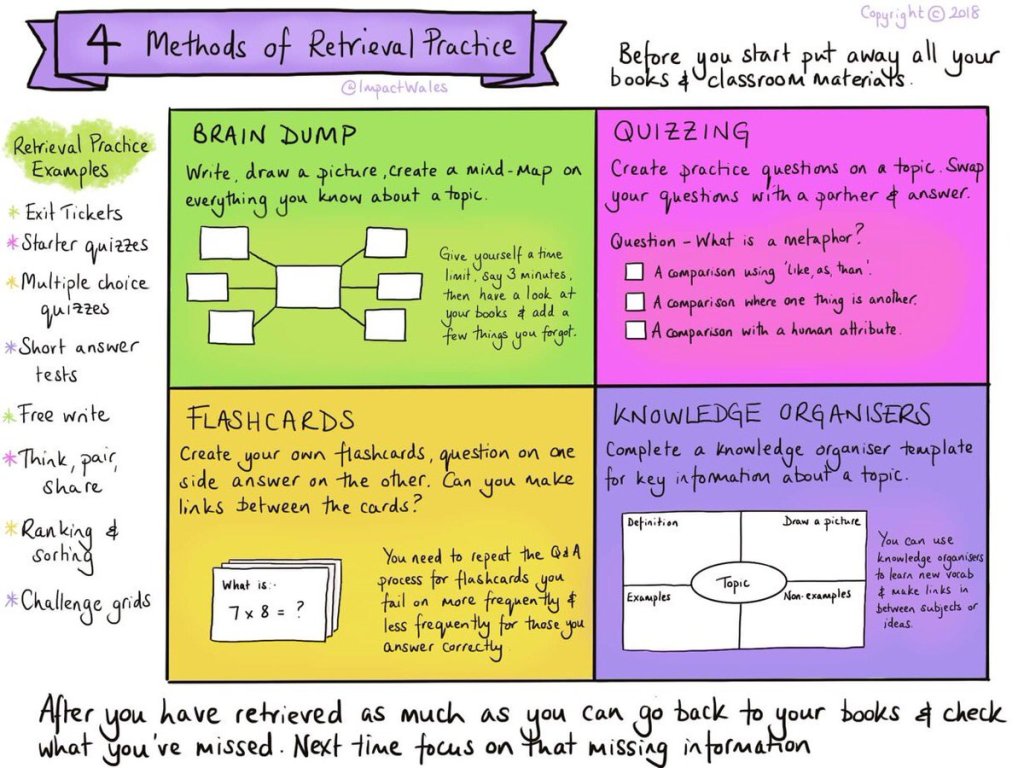
Sketchnote about Retrieval Practice 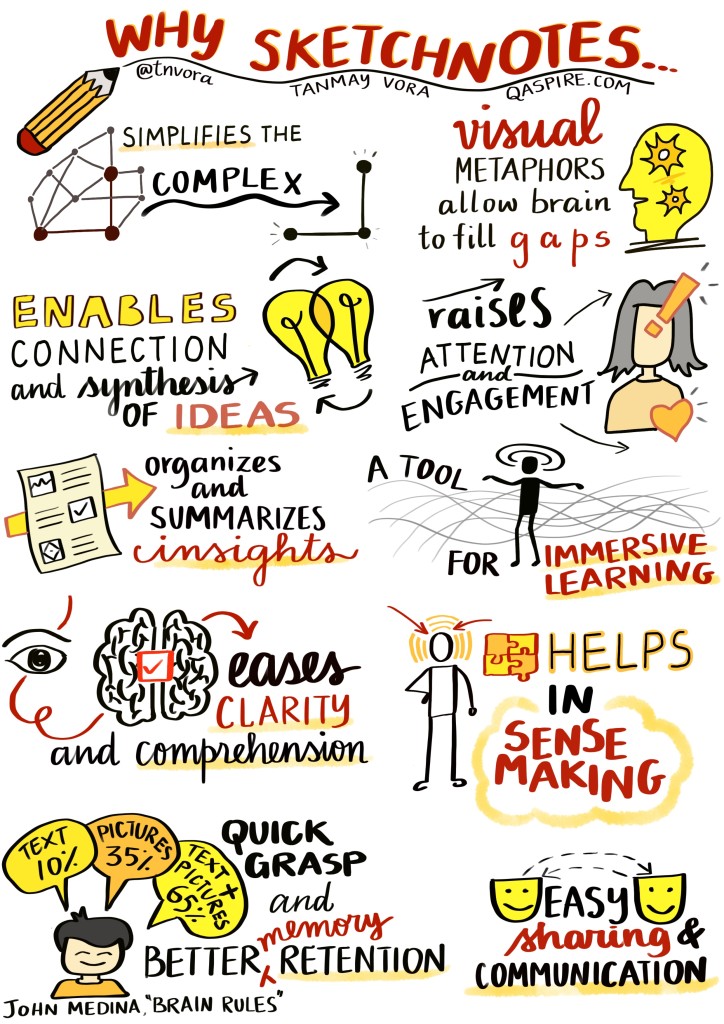
See below for the workshop slides, links and further resources
Sketchnote like a Whiz and effective strategies for learning






See below for the workshop slides, links and further resources
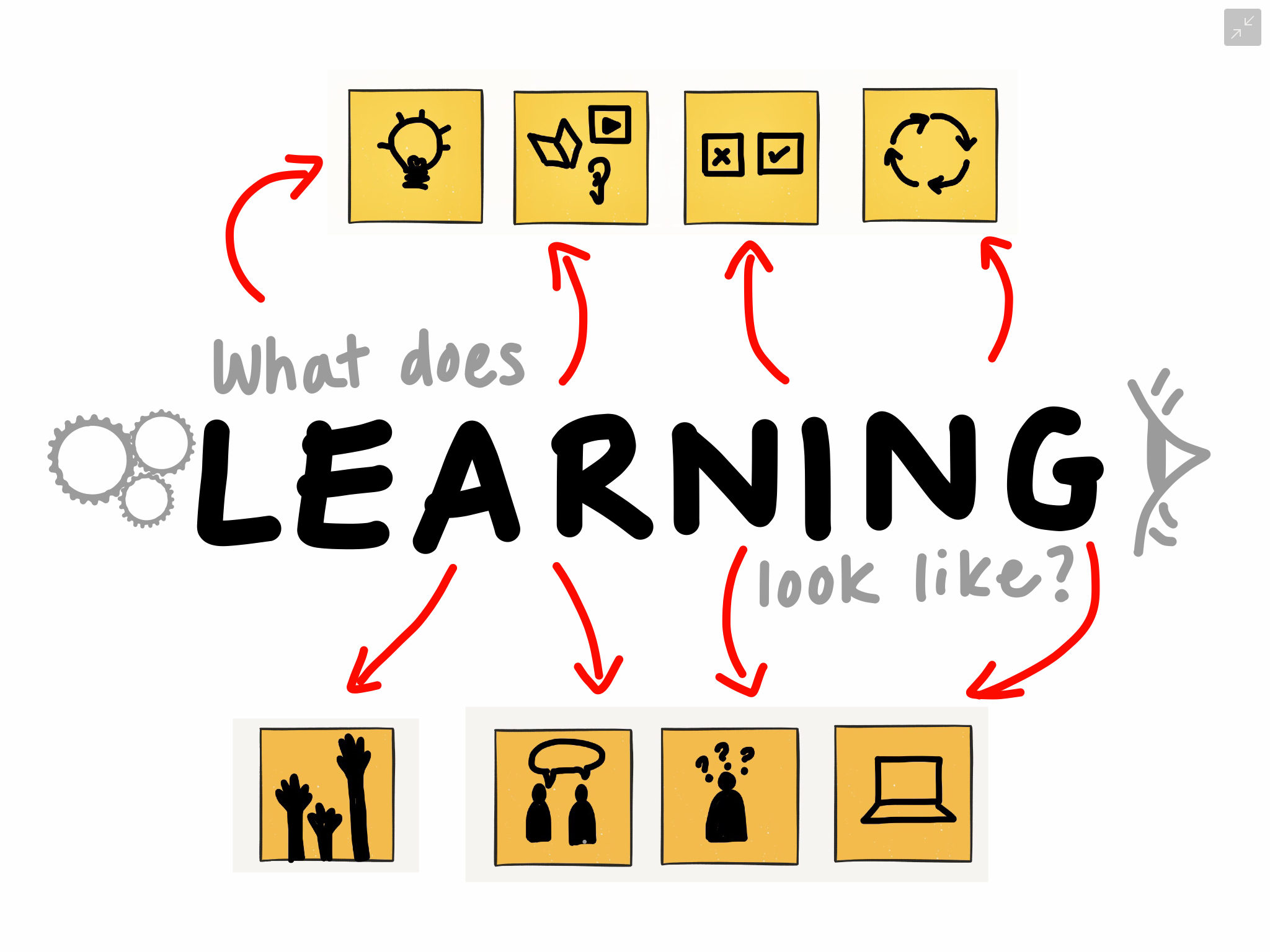
What does Learning Look like? Post it Crazy 8 thinking routine challenge by Nicki Hambleton
Think of a lesson you have been planning.
You might have spent hours putting together the most engaging lesson for your students: visuals and slides mapped out, handouts printed, you’ve planned fun and varied activities and you have probing questions at the ready.
You have taught this lesson a hundred times so you know the content well. But how will you know if your students have really understood and learnt anything?
I asked the same question to a group of educators at the Learning 2 conference, Warsaw back in April, where I was running an extended session called Learning and Thinking Out Loud through visual note taking and thinking routines. I used the simple routine Crazy 8, first demonstrated to me by Kelly Grogan and Ed Chang from the Chinese International School, HK at the iPad conference held at UWCSEA.
I explained that they would be drawing 1 idea per post it every 20 seconds (a feat most thought they would be incapable of, but weren’t!). Each idea drawn would represent what learning looks like. To show them what I meant, I drew a quick example:

quick doodle for collaborative learning
At the end of the 3 minutes their ideas looked like this:
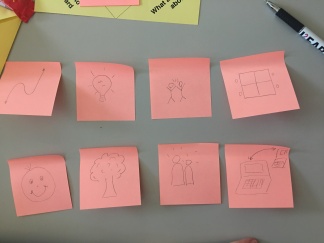
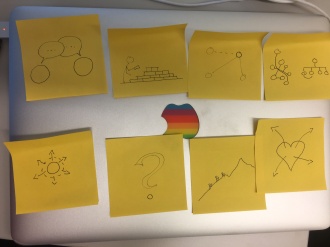
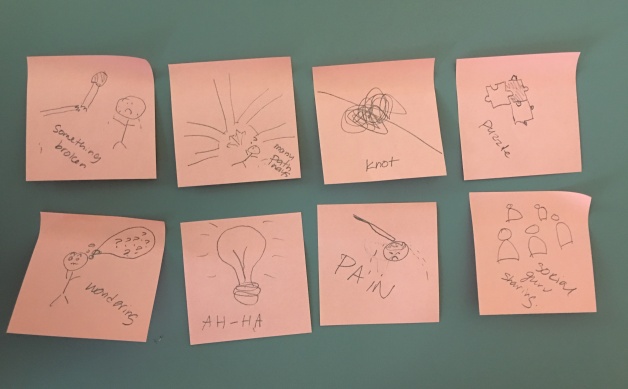
We shared thoughts and discussed what they had drawn with comments such as:
“Learning can be messy”, “Learning is never ending” and “Learning should be fun”.

Photo from Learning 2 conference, Warsaw, April 2017
What learning actually looks like and what it should look like can be quite different, but learning out loud, making it more visible and tangible can aid further discussion and understanding of that thought process.
What would you draw for What Learning Looks Like?
What alternative question might you ask in your classroom for students to draw their responses using the Crazy 8 thinking routine?

Photo Credit: Alan Vernon. Flickr via Compfight cc
When I was at school, learning was predominantly teacher led and all about listening, reading and writing, with exams at the end of the year. I don’t recall there being any student choice, collaboration or to that extent much fun, but that’s how it was.
In my classroom today, my students share that they are more empowered by autonomy and choice and, wherever it is possible, I try to include them in the planning process. But how do I know that they are learning or indeed, what they are learning?
You may be thinking that learning in Art is quite obvious as it is visual – a drawing, sculpture or painting. But how do I know whether they have truly understood the concept, the skill or technique? How do I know what is going on in their heads?
When learning only goes on only in one’s head we cannot see it, understand it or question it. We cannot track the thought process, probe into their thinking or push ideas in other directions. It is only when we get students to visualise their thinking that we can start to understand their processes, methods and see the way they work.
If you haven’t read the book “Making Thinking Visible” by Ritchhart, Church and Morrison or “Creating Cultures of Thinking” by Ron Ritchhart or devoured the resources on the website Project Zero and the Visible thinking routines, I strongly urge you to do so at you earliest convenience, I promise you will not regret it.
Project Zero began 50 years ago, led by a team of researchers including Howard Gardiner, discussing the cognitive skills needed for arts education and conceptual understanding through the arts.
You can find multiple, easy to use thinking routines through the website and many educators from elementary to high school use these to enhance and visualise thinking in their classrooms.
The best way to start is to choose just one routine and try it in different ways with different concepts and classes.

My most favoured routine is SEE THINK WONDER, which I use when introducing a new artist or art form such as installation art, when reflecting or giving feedback and when analysing or discussing artworks. During a discussion, it allows students to think more out loud, hear others ideas and to expand their own thinking. For Middle School art students it opens their minds at the start of a new unit and allows them to ask questions and wonder about the meaning or reason behind the artwork. In short, it gets them thinking more independently.
You can read more about the Making Learning Visible online course on their website and about UWCSEA’s group experience in a previous post of mine.
Recently I stumbled on a new routine, via Simon Brooks’ website called 8 to 1, where students whittle complex concepts into more manageable understandings, essentially by capturing it in 8 words, then 4, 2 and eventually down to one word:
1. If you were to write exactly 8 words that captured the heart of what should be remembered, what would those 8 words be?
2. Now that you have your 8, can you distill them down to 4?
3. And 2?
4. And 1?
5. REFLECT: Share your 8 words, your 2 words and your 1 word. How did your thinking change? What did you learn about what’s most important here?
Sharing their thinking seems to be at the heart of the routine and I see this as the most valuable learning experience for them. Brook posts a student example, below, relating to Hamlet’s speech but this routine could easily apply to IB Physics, HS Geography or MS Art.
How might you try out this routine in your class?
How could this help students to share their learning?
How does learning look different in other curriculum areas?
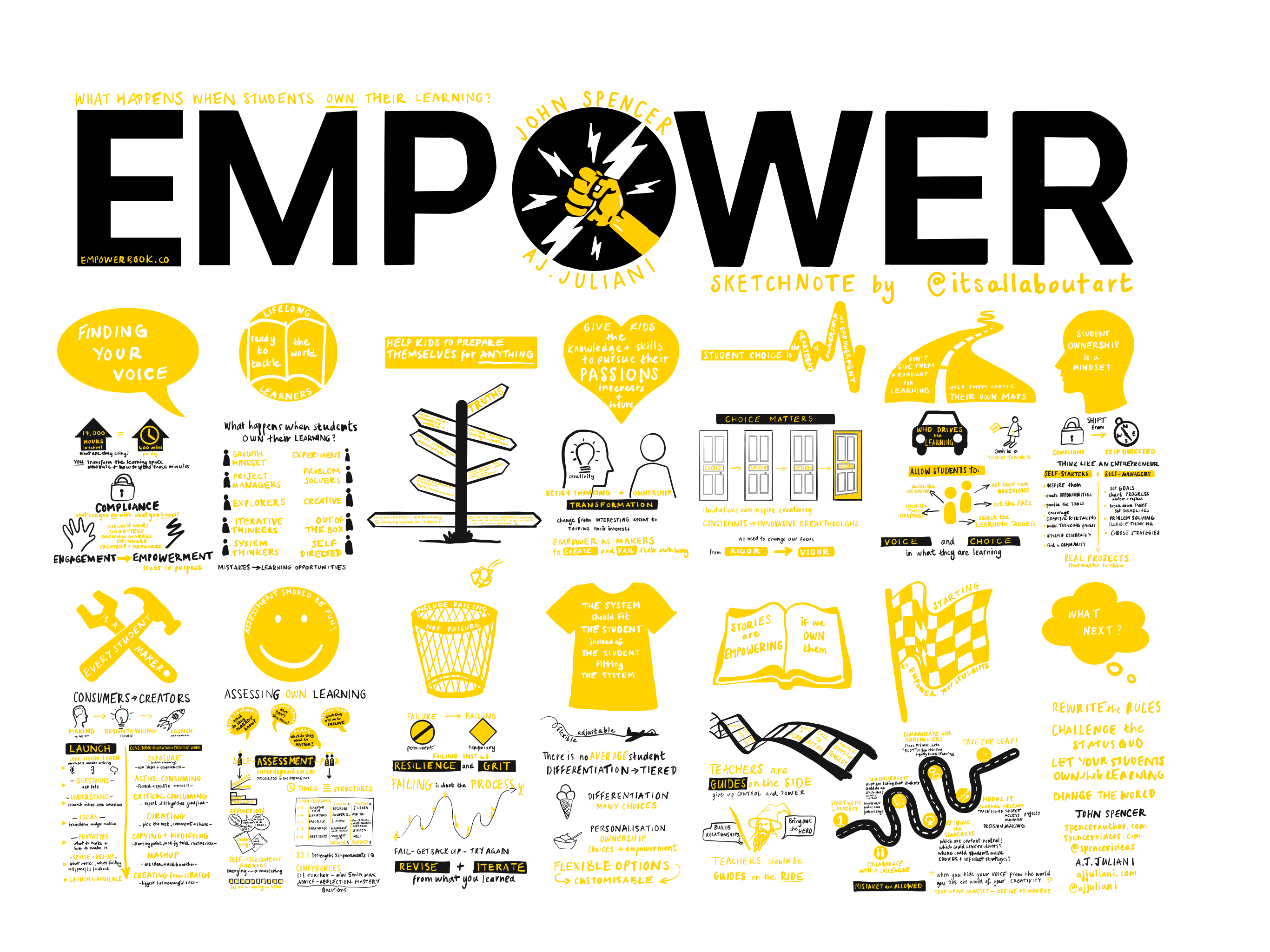
EMPOWER sketchnote by Nicki Hambleton drawn on iPad using Adobe Draw
Student choice is the heartbeat of ownership and empowerment
so what can we do to ensure this is integral in our students learning? How do you integrate personalised learning into your lessons?
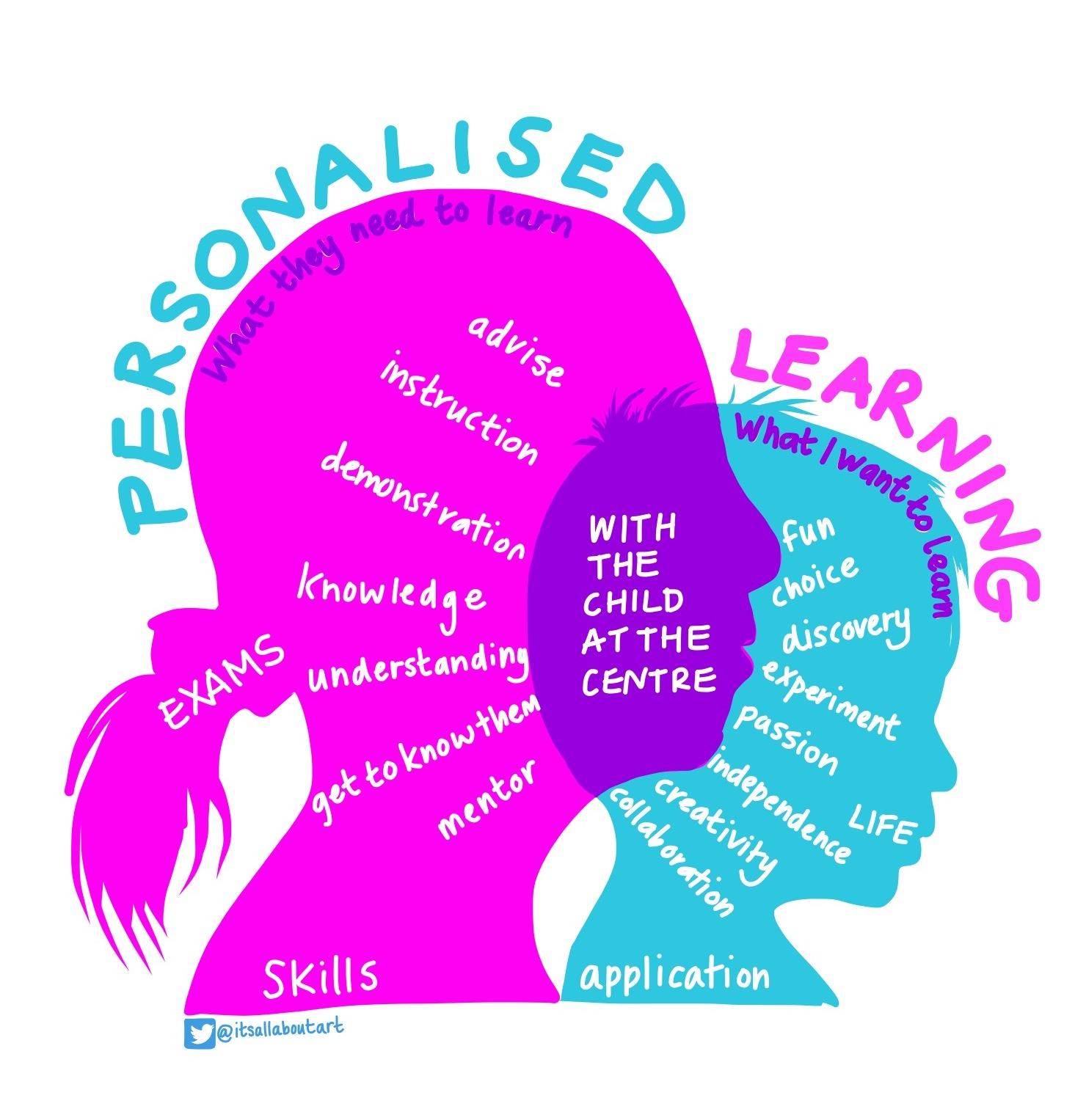
Personalised Learning visual note by Nicki Hambleton using Adobe Ideas on iPad
The book has certainly given me much food for thought here relaxing in Italy, sipping rich red Tuscan wine and munching on sweet succulent tomatoes and bruschetta.
What have you read this summer that has changed your thinking?
How can you embody the ideas in Empower to help students own their learning?
What does learning look like in your classroom?
One of my goals for the next academic year is to build students’ skills in self-directedness and, to help this process I have been investigating Hyperdocs as a strategy to guide students through the unit yet allowing them choice and time for personal progression. Hyperdocs are a possible solution to personalised learning using technology to gather multiple resources online.
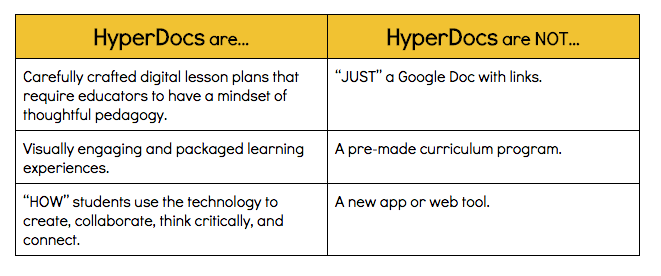
Hyperdocs.co
Hyperdocs, a transformative, interactive Google Doc replacing the worksheet method of delivering instruction, is the ultimate change agent in the blended learning classroom.
You can read more about Hyperdocs on Cult of Pedagogy or on the main Hyperdocs site. Have you used Hypedocs yet? How has this changed student learning?
I would love to hear about your experiences, challenges and thoughts on personalised learning, empowerment and any other ideas you have for making thinking more visible.
Please share your experiences and ideas in the comments below.
This blog post was a reflection of and in response to the powerful TED talk by Will Richardson “The Surprising Truth about Learning in School”.
Whatever we do, whatever we teach, whatever wondrous new fandangled gadget or app appears on the market, whoever we teach and whenever we are teaching them, learning should be at the heart of it.
It may sound crass or even naive, but often in this brave new world this fundamental aspect is forgotten or at least pushed further and further backwards. Literacy hour, genius hour, standards and benchmarks, aims and objectives, collaborative work, group work, authentic use of technology and many more bombard our daily practice and jostle for space in the short amount of time we have with our students.
In Middle School Art, students have but a mere 75 minutes to learn and grow as a artist over the year, and with Sports Days, visiting speakers, training days and public holidays sometimes this can be whittled down to just 30 lessons. This equates to around 37.5 hours, just over a day and a half. What can you teach a 12 year old for a year if you only had a day and half? If assemblies run over or it is the start or end of a term some of this time would be reduced even more.
So, how do we prioritise what we want our students to learn?
IB PYP philosophy promotes purposeful inquiry as the leading vehicle for learning and through this it is clear that students are the key, the centre of learning and that they need and want ownership of their education. They may not have the skills nor the knowledge, yet they know what they want and need and, with guidance, can and should help to shape the lessons. It may again be naive of me to think that children can plan your curriculum but we spend so much time as adults forgetting what it is like to be a child and what it means to learn as a child. They want to know why they need to learn this concept or that information or skill, and what use it is in today’s changing society. We cannot neglect that the world is a very different place to that which we grew up and learned in: we must think in the shoes of our students more often and ask them their opinions and ideas. So, even though I do not teach PYP, I honour the philosophy and turn the discussions over to them. I ask my students what they want to learn and what they think they need to learn to be a better artist, thinker, problem solver, collaborator, team player, independent learner and what the use of learning art is.
It is an eye opener. It develops new thinking and shapes the curriculum.
When I worked in the UK, a judgement of a child’s success was based on “value added”. What did students come into the school with (or at what level) and what did they leave with (and at what level) compared to the expectation? For those too young to have heard this phrase in education, here is a simple diagram to explain this concept:
What might surprise you is that this assessment is centred around the teacher not the child, rather the child as a result of the teaching. Not something that ever sat well with me or, for that matter, many teachers. How can we measure learning? Is it possible solely by testing?
Last year, in Florida,
the teachers’ suit challenged the state’s 2011 Student Success Act that requires school districts to evaluate teachers based in part on “student learning growth” — defined by increases in standardised test scores. Florida is one of several states that have passed “value added” teacher evaluation laws linking teacher merit pay and retention to students’ standardised test performances. (Law Professors, May 2014)
The judge found Florida’s teacher evaluation unfair, but legal. How else can we assess learning and student growth in a less numerical or judgmental fashion?
What value have I added to my students this year? What new learning has happened through Quadblogging?
For most, blogging at the Dover Campus is a new thing. A handful of students had a blog in Primary school or with their Spanish teacher, but on the whole, connecting and posting online was a new experience and one that needed nurturing. It astounded me that, in their social media-centric lives, they were unaware of what makes a valuable contribution to commenting, so it was here that I started to teach them real value in their words. We have worked all year on purposeful feedback with peer groups verbally at several stages in their work using various models such as “I see I think I wonder”, “invisible artist” and even “poo sandwich”, a phrase coined by one of my Science colleagues (don’t ask!). Armed with the skills and strategies to comment intelligently and meaningfully, we tested the waters commenting locally before embarking on public sites, trialling post it comments at the High School Art Exhibition, sending emails to the artists and practicing in a Picasa web album of their own class’s photography. They began to see the real power of their words, discussing starting sentences and suggested etiquette to keep themselves both on track as well as respectful.
The biggest learning so far was that of questioning. During the blogging process they figured out that when they asked the artist a question or reached out in their own post inviting critique or connections, they added value to their own thinking but also that of the receiver. It helped them to connect and began to form a conversation: a 2 way conversation. This in itself was powerful learning and prepared them well for the blogging ahead.
Reflecting on my own learning over the past year I can see so much growth in the manner I present my findings, in the depth of my posts and the actions I have taken back in the classroom. I have documented this through writings and drawings but the real results are less easy to measure or see as they are deep within the curriculum development, the forward planning and the nuances of my lessons. If you were to ask my students how the lessons have changed, I am not sure that they will have noticed drastic changes, more gradual drip feeding or subtle additions, as I am loath to add a new app or concept just for the sake of it, especially with time being so precious. I believe in authentic use of technology that doesn’t dominate the learning, it enhances or transforms it and this takes time to develop and authenticate. I yearn for the day when my students pick up an iPad or use an app or software of their own choosing as just another tool in their kit to learn with. I feel we are fast approaching this and we have to race to keep up with the plethora of new ideas firing at us and to filter the most effective ones to teach our students that would benefit their learning. What does this swiss army knife of new skills look like? Teachers should pool the ideas they offer students so other curriculum areas know what students can pick and choose from. What does your bag of tricks look like?
Picking from my own COETAIL bag of tricks I found so many aspects I wanted to focus on when developing my Course 5 project. For me, at the heart of COETAIL, and its ultimate success and longevity, is connecting and sharing. My wish was for my own students to develop their own online communities in a similar manner so that they too could grow and learn. But now I look back and think, is this me, as an adult, thinking I know what is best for them to learn better? What if I thought more in the shoes of a 12 year old, as a child, learning art surrounded by all the influences and distractions a child in today’s world has? What would I want to learn and how?
Holistic education is at the centre of UWCSEA and our mission states:
The UWC movement makes education a force to unite people, nations and cultures for peace and a sustainable future. The UWCSEA goal is to educate individuals to embrace challenge and take responsibility for shaping a better world.
Kurt Hahn’s philosophy is at the heart of how students learn.
He championed the importance of developing the whole person, and based his thinking on the ideals of a holistic, experiential, values-based education.
“I regard it as the foremost task of education to insure the survival of these qualities: an enterprising curiosity, an undefeatable spirit, tenacity in pursuit, readiness for sensible self denial, and above all, compassion.” Kurt Hahn
The world is a very different place since Hahn founded the UWC movement 50 years ago. But his educational philosophy, with a focus on academic achievement, leadership, experiential learning and service to others has remained, and will continue to provide our students with a unique learning experience for many more years to come. (From UWCSEA website)
Experiential learning should be at the heart of our lessons and Ed Batista sets this out in his article on How to get Unstuck back in April 2010. Referencing Jessica Hagy and Andrea Corny’s models I believe the simplest is the most effective: What? So What? Now What? and Do it! hits the mark.
It has been both exhilarating as it has been daunting working through Course 5. Self motivation is at the heart of self-directed learning and time seems to run away from one, especially in a busy place like a school. But we are adults and at the end of a course that has taught us well, modelling research and structure enough so that we cannot possibly flounder at the last hurdle. How can we learn from this experience and help our students to be more self directed, motivated, organised and committed right up until the final flag?
Perhaps planning the year around this model would work, beginning with teacher-led instruction and demonstrations, modelling good working practice. Then, as the year unfolds, the next unit has some aspects of self-directed learning with guidance and a little hand-holding leading up to the final term. Lisa Nalbone neatly demonstrates the process of self-directed learning in her diagram below. Starting with a question changed how I looked at learning in my classroom as well as within COETAIL and asking students to ask more questions to direct learning is a powerful way to start in any subject area of the curriculum.
Looking back at COETAIL, the aspect that influenced, inspired me and changed my thinking the most was Course 4. It lit a fire. I would like to try to integrate gamification, or at the least some aspect of motivational learning into the framework next year to urge and push students in their pursuit of growth.
As I am currently at the stage of reflection on the course and in the final term of the academic year, I figured that it would be good to test the waters and ask the students: what they wanted to learn, how they learn best, what helped them to learn and grow this year and how they might demonstrate this learning? A large proportion of my students say they learn best by “trial and error”, their words not mine. Many said they learn best by seeing and doing, experimenting and trying out and this has been at the heart of this Connected Classrooms project. I said at the start I did not know where it was going to go, and I still don’t. I am letting the students lead the way, make the choices of how to alter the course and to find new ways to do what they used to do. It takes me back to the beginning of my course and the visual:
But it also draws me closer the the fundamentals of SAMR and redefining learning. With the learning firmly in the hands of my students I am excited for what happens during the final weeks of the course yet even more for what happens after. I am pushing the learning right up to the last minute of COETAIL, desperate for it not to end and to squeeze as much out of it as I can. I am a long way from personalised learning but I am heading in the right direction, slowly. The next posts will track the choices they make, the collaborations they plan, the gamification of the learning and finally the results of their work.
Watch this space….
“Education is not the filling of a pail, it is the lighting of a fire” W.B.Keats
What fires have you lit today?

Connectedness visual note by Nicki Hambleton
As the evening of Valentine’s Day was drawing to a close, I stumbled on an article from Mashable that had been shared on Facebook and the title caught my eye:
The story goes like this: Guy wants to propose, decides on Portland, contacts stranger through Instagram for help, guy proposes, girl accepts. Of course the article tells it much more beautifully than that and with an accompanying digital story. But what fascinated me was this connection and trust in complete strangers on what was probably the most important day of his life. I use Instagram purely as a photography sharing place, more often than not with food shots or stimuli for just great composition or ideas. Strangers follow me, I follow strangers. It is a strange concept to me but it works. However I would never have thought of connecting with others like @iamcartermoore. When I first joined Instagram I was not sure of what was expected, the etiquette or even the point. This felt a bit similar to the “lurking” stages of the early relationship I had with Twitter. I watched, took note, occasionally posted. Carter found kindred spirit and connection with Branden Harvey, a fellow photographer and film maker and through this random link they became life long friends.
According to George Siemans, “connectivism starts with the individual” and that the “learner remains current in their field through the connections they have formed”. (A Learning Theory for the Digital Age 2004)
My relationship with Twitter follows not such dramatic or love struck storyline as Carter Moore’s but with a similar sentiment. From taking that first step of observing and reaching out, to connecting and interacting with others and developing friendships that the true power of the internet is clear. By making these connections so we grow, our reach is further and interactions stronger.
It has been a busy week with food for thought. During the COETAIL live cast on Tuesday, listening to the conversations flow, it was a statement by Dana Watts that stood out. ” We learn most by collaborating together with others”. It got me thinking:
How do the youth of today connect and grow as learners? In what ways is this different to how we learnt as teenagers and how we now connect to grow and develop as adults?
We have always been connected it’s just our reach goes out further these days with the Internet.
Last week’s post took me back to “7 degrees of connectedness” by Rodd Lucier and that how to be truly connected we must work at how we connect and what we actively do as part of these connections. It was by initially “messing around” with Twitter and stumbling on blogs that I grew as an educator and learner – it was the most effective PD I had ever had and one that I was controlling. By scrolling through my feed often an article or link would grab my attention and take me forward. So is this the way my students learn?
It is like those happy accidents when mixing paint or doodling with an idea, or playing with the ingredients of a cake or casserole that new directions are born.
It is when we are looking for something else that we usually find something that becomes the hinge pin, the starter, the turning point. It’s like playing in the sandpit as a kid. No rules, just fun.
Whilst reading “Messing About” (Living with New Media) I wonder how youngsters increase their own learning when challenged by something that they are passionate about.
I watch my son Luca, transfixed and thoroughly engrossed in his latest new kingdom on Minecraft. He is in control of his learning, growing exponentially and to think that it all started with a brick, a little piece of lego that evolved into what is arguably one of the most successful games with youngsters. The power of Minecraft- teaching kids to dabble, tinker and mess around, find their way, share and play.
The opportunities for using and developing your creativity by dabbling and playing with ideas is not a new one. As a teenager myself, I messed with ideas and sketches, devoured books and magazines to feed my creativity and spark new direction. Luca shows me how he is building a pirate ship on Minecraft, following a Youtube video. He is ten and he is not alone. This is the world they have grown up in. Youtube is the biggest and most extensive instructions manual on anything you could ever want.
In school, Hamish in Grade 7 shows me an app he is building to help support and raise awareness of our Global Concern group, PAW (Promoting Animal Welfare). In order to do this he has had to learn how to code, dabbling with the software and through trial and error discovering what it can do. He says he frequently finds information through Youtube tutorials. My eldest son Piers is passionate about model trains and shares this through his Youtube channel, connecting with strangers to share his passion. Olivia studying iGCSE Visual Art in Grade 9 uses Tumblr as her go-to site. Here she discovers a plethora of visual inspiration and artists all over the world to share and connect with. Nanako, also a Grade 9 Art student, tells me how she first “messed around” with Photoshop and a tablet to create her own art. She backs up MacArthur’s claim that it is only through interest-driven subjects that students will actively pursue and maintain this stage of learning and again her preferred method is to try things out, tinker with the software and, if need be, use Youtube tutorials to steer her in the right direction. Nanako is one of our Apple Orchard students and to whom connections across our region are hugely beneficial as an artist. She adds that this stage of learning only works if the area is self chosen and one that she is passionate about; teens simply would not have this same level of drive in a subject or topic they are not interested in.
But it is still on Facebook that students work and collaborate together, using FB groups to ask and answer questions about schoolwork. These closed but valuable communities support their learning and give them much needed support through the social media they interact with the most. It is still the most used platform for the youth of today.
Andrew Marcinek says in his blog post, “Students get it. They understand how easy it is to connect with one another, but don’t fully realize the greater potential.” (“Help Students Use Social Media to Empower, Not Just Connect” Edutopia 2010). I still wonder why Twitter is so underused as a portal for posing questions from the youth and as their learning zone. I can see the benefit of its use in class but I am halted by the over 13 restrictions with my Middle-schoolers.
I would love to pilot Google + communities with a class or group and see how they could use it to connect and interact. But our school has not switched Google+ on for students yet, so I wonder if anyone has any other suggestions for helping young students to connect? I have ideas to connect students on Skype with an artist in London we are studying as part of an Expressive Painting unit and to link my GC PAW participants with fellow activists and animal lovers worldwide to collaborate to raise awareness.
Is FB the most popular outlet because of its “socialness”, its distractibility; “I can just look at this for a moment so I don’t have to do my science homework”. We have all done that/do this: I’ll just look at that interesting article on Colossal or take that “What city am I?” quiz instead of writing reports… or just read another COETAILer post!
So what is more important – spending time connecting with others to build your PLN and learn from them or to spend that time surfing, discovering and stumbling on something that could be the start of a new direction for you. Clearly both are valuable and we cannot progress without the opportunities for either to occur.
So where do we find the time to dabble and play in the jam-packed 24 hours we have each day?

Photo Credit: Alan Cleaver via Compfight cc

Profesional learning, ideas and resources for EAL and MFL teachers
Instructional design tools & insight
Exploring creativity through art